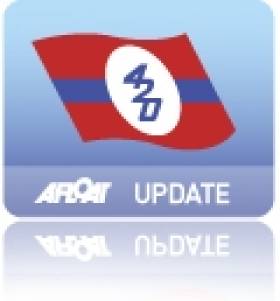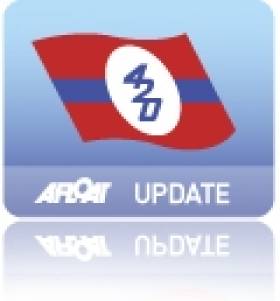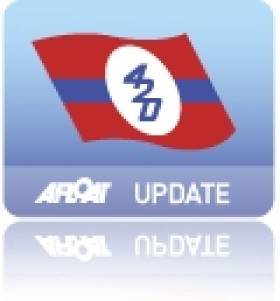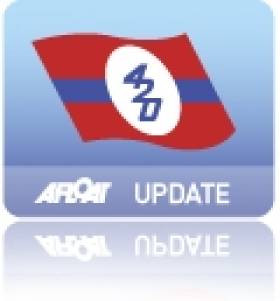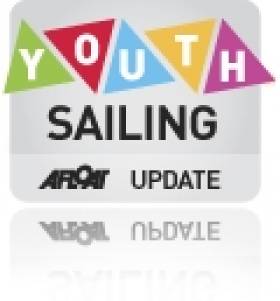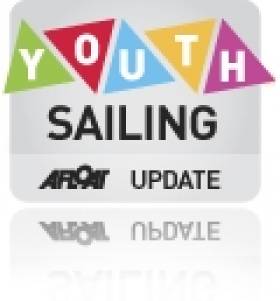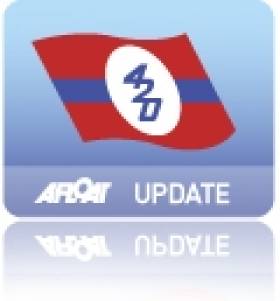Displaying items by tag: 420
Howth 420 Pair Make Top Ten of Youth Europeans
#420 – After a good start, Howth's Robert Dickson/Sean Waddilove are in the top ten of the 420 Youth Europeans in Poland. Royal Cork's Harry Whitaker and Grattan Roberts are 13th with club mates Peter McCann and Arran Walsh in 16. The crews are part of a seven boat Irish 420 team competing.
Top 10 finishes for series leaders Hippolyte Machetti/Sidoine Dantes from France means they continue to control the leader board in first overall with 10, 3 finishes.
Ewa Romaniuk/Katarzyna Goralska move up into second on the leader board from more solid results with a 10,5 performance and rank as the top placed girls team. Seven points behind are the USA's Will Logue/Bram Brakman in third overall.
At the 2013 420 Junior Europeans Romaniuk/Goralska faltered after a strong start, but they are determined to use the past year's experience, including their career best of a bronze medal at the ISAF Youth Worlds, to finish on the podium at the 2014 420 Junior Europeans.
"We have grown up since last year and gained more experience," commented Romaniuk. "We have trained hard over the past winter to prepare for this year's Championship."
The team's bronze medal at the ISAF Youth Worlds was a perfect execution of race delivery and controlling nerves. They went into the final race in 5th overall, and with many other teams able to secure silver and bronze, the won the race and finished their second ISAF Youth Worlds appearance on the podium.
Joining the Polish as the only girls teams in the top 10 are Greece's Aikaterini Tavoulari/Fotini Koutsoumpou in 7th and Clara Addari/Arianna Perini (ITA) in 9th.
Eight nations are represented in the top 10 as the leaderboard changed hands several times today.
Two more races are scheduled on Friday 15 August to complete the qualification stage for the 2014 420 Junior European Championships. Results after tomorrow's racing will see the 108 boat fleet split into gold and silver, with 54 boats in each fleet, for the final series of 6 races. The discard kicks in after race 5 tomorrow, so some changes in the top 10 are expected. Racing for the 420 fleets is scheduled to get underway at 1130 hours on Delta course, with the yellow fleet racing first, followed by blue fleet.
420 - Results after 4 Races
1. Hippolyte Machetti/Sidoine Dantes (FRA-55096) - 17 pts
2. Ewa Romaniuk/Katarzyna Goralska (POL-55326) - 25 pts
3. Will Logue/Bram Brakman (USA-55175) - 32 pts
4. Russell Clarida/Henry Fernberger (USA-54068) - 37 pts
5. Thomas Ponthieu/Quentin Paturle (FRA-55095) – 38 pts
6. Kilian Wagen/Gregoire Siegwart (SUI-52967) – 40 pts
7. Bart Lambriex/Philip Meijer (NED-54005) - 44 pts
8. Aikaterini Tavoulari/Fotini Koutsoumpou (GRE-54484) – 45 pts
9. Frederik Eichhorst/Julius Erbach (GER-52784) – 49 pts
10. Robert Dickson/Sean Waddilove (IRL-54417) – 52 pts
Full results here
Seven Irish Teams Contest 420 Dinghy Youth Euros in Poland
#420sailing – Four Royal Cork, two Howth/Skerries combinations plus a Kinsale YC and Malahide YC team will contest the 420 and 470 Junior European Championships in Gdynia, Poland this morning.
The seven boat Irish youth sailing line up comprises Harry Whitaker and Grattan Roberts, RCYC; Peter McCann and Arran Walsh RCYC; Lizzy McDowell and Cara McDowell Malahide Yacht Club; Douglas Elmes and Bill Staunton, RCYC; and Skerries/HYC; Robert Dickson and Sean Waddilove, Howth YC/Skerries SC; Cliodhna Ni Shuilleabhain and Jil McGinley Kinsale YC and Royal Cork YC and Ewan McMahon and Colin O'Sullivan, Howth.
The two Junior European Championships are held alongside each other to support the natural transition between the 420 and 470, although the racing format and course areas are separate.
A total of 332 sailors are competing, with teams from 25 nations contesting the 420 Junior Europeans and 470 Junior Europeans. Joining the European nations are teams from Australia, Canada, Hong Kong, New Zealand and the USA.
Warm-up events for both classes has seen the 470 Class running a three-day training clinic led by world-class coach Nigel Cochrane (CAN), whilst the 420 fleet has enjoyed the Polish 420 National Championships as a training ground. The 420 National Championships gave an early taste of form with fifty-eight teams competing, including twenty-five international teams. The Nationals was won by Greece's Nikolaos Brilakis/Nikolaos Georgakopoulos and top ladies team were Poland's Ewa Romaniuk/KataRzyna Goralska in second overall.
Some of the sport's most talented youth teams are set to flex their muscles on the race tracks of Gdynia, including the 2014 470 Men Junior World Champions, 470 Women Junior World Championship podium finishers, the defending 470 Women Junior European Champions and a stellar line up of 420 sailors including medallists from the recently held 420 World Championships and the ISAF Youth Sailing World Championships.
Keeping Poland's ambitions burning strong are 38 of the nation's best young sailors, with ten teams in the 470 fleets and a fourteen-boat line-up in the 420 Class.
The 2014 420 and 470 Junior European Championships officially opened this evening at an opening followed by sailors' buffet.
470 MEN AND WOMEN
Reigning 470 Junior World Champions, Jordi Xammar/Joan Herp of Spain successfully defended their 2013 Junior World Championship title in Italy in June and are now on a quest to do the double this year and add the 470 Junior European Championship to their growing gold medal haul. After their win at the 2013 470 Junior Worlds, the pair fell short of the podium at the 2013 Junior Europeans, finishing 4th by 10 points, so are back to make amends. Competing here in Poland was a last minute decision for the pair who were on vacation and simply had an overwhelming mission to compete and try to claim the Championship medal which has so far eluded them.
"We were not planning to come, but then we decided we'd better come just to see what we could do here," smiled Xammar. "The 470 Junior Europeans has not been our Championships. We have won five other junior world titles and this is the only one we haven't won."
Predicting what will give them the edge on the race track, Xammar continued, "The wind conditions and speed are not going to be the priority here. I think more important will be tactics and strategy around the race course."
The Spanish are joined by six of the other teams in the overall top 10 from the 470 Men Junior Worlds, so an intense battle is on the cards.
In the 470 Women, defending 470 Women Junior European gold medallists Anna Kyselova/Anastasiya Krasko from the Ukraine are back to defend national pride. The pair claimed silver at the 2013 Junior Worlds, but with a raft of penalty scores at this year's 470 Junior Worlds year in Italy failed to show their true form, and didn't qualify into the Medal Race top ten 10. The pair have parked that that disappointment firmly behind them and know they can win gold here if they focus on a consistent scoreline.
Teams lining up against them include silver medallists at the 470 Junior Worlds Jess Lavery/Megan Brickwood from Great Britain and the bronze medallists Noya Bar-Am/Rimon Shoshan from Israel, These three teams, are joined by five more of the top 10 from the 470 Junior Worlds in italy.
The British pair have had a break from international competition since the Junior Worlds, focusing on work commitments and training in the UK, so are also fresh to the race track.
"We have had a good few days training out here and had some good tuning with the Canadian team," commented Lavery. "It has gone well so far and we are getting familiar with the venue and feeling happy with how we are sailing."
The 470 Men and Women will race as two separate fleets, each fleet contesting a single series of 10 races, followed by the ten-boat Medal Race final. Racing is scheduled to get underway at 1100 hours on Wednesday 13 August 2014.
420 OPEN
In the 420 fleet, there are numerous familiar faces who have headed to Poland straight from the 420 Worlds in Travemuende, Germany and are back on the race track for the 420 Junior Europeans. To ensure quality of racing, entries are limited with a strict quota of seven teams per nation, apart from the host nation who can enter 14 teams. Teams race all together, so mixed teams, men and ladies teams all up against each other.
In 2013, the 420 Ladies controlled the leaderboard, claiming gold and silver, with the men's teams surprisingly off the pace in last year's windy conditions at Pwllheli, Wales.
Lighter winds are forecast for the Championship here in Poland, but judging from today's practice race, it may be more to do with who can read the wind best as shifty conditions look set to prevail.
Spain's Silvia Mas/Marta Davila won the ladies 420 division at the ISAF Youth Worlds and are looking forward to the challenge of racing in an open fleet
"I think for me it is more fun," laughed Mas. "It is a different thing just sailing with just girls compared to mixed. In the lighter winds the girls all do better, but we drop down when the wind picks up. I think it is really fun to sail all together."
"It is a bit shifty and the waves are quite difficult, particularly on starboard," she continued. "But it is the same for everybody."
The summer has been a gruelling back to back schedule of Championships, which take their toll.
"I am a bit tired," said Mas. "But I am feeling OK as although I have raced lots of Championships I have learnt a lot."
Also amongst the pre-race favourites will be the silver medallists at the 420 Worlds, Hippolyte Macheti/Sidoine Dantes of France who were also honoured as the top team placed team aged 18 and under and crowned Junior 420 World Champions.
As well as the Greek winners of the Polish 420 National Championships, local 420 team Ewa Romaniuk/KataRzyna Goralska will also be amongst the frontrunners.
Romaniuk/KataRzyna Goralska dominated during the early stages of the last year's 420 Junior Europeans, before struggling to maintain consistency and finishing 11th overall. But 2013 was a different game, as it marked their first season together. Rock forwards 12 months and the pair have far more experience to their credit and also secured the bronze medal at this year's ISAF Youth Worlds, up from 9th overall in 2014. They didn't compete at the 420 Worlds earlier in August, so are fresh for racing here in Gdynia.
Absent from the start line will be recently crowned 420 Ladies World Champions, Italy's Carlotta Omari/Francesca Russo Cirillo, and silver medallists Kimberly Lim/Savannah Siew who flew back to Singapore to prepare for upcoming school exams. Their absence also leaves the door open for the 420 Worlds bronze medallists Aikaterini Tavoulari/Fotini Koutsoumpou of Greece to step up. The pair gave the series leaders a run for their money in Germany and can do the same in Poland, particularly after their 7th overall at the Polish 420 Nationals.
There are numerous faces who can rise to the top from the 108 talented 420 teams competing, so expect some early leaderboard charges from Wednesday's opening three races.
Racing Schedule
Racing kicks off on Wednesday 13 August with three races scheduled for all fleets starting at 1100 hours. The 108 boat 420 Fleet have been split into two fleets, yellow and blue and will be re-seeded for each of the three days of qualification, after which they will advance through to gold and silver fleets for the final series.
The 470 Men and 470 Women are sailing a single race series in separate fleets, with 11 races scheduled followed by the top 10 Medal Race.
Top 20 Finish for Howth 420 Dinghy Duo at German World Champs
#420 – This year's Ulster and Connacht 420 dinghy champions Robert Dickson and Sean Waddilove finished 20th at the World Championships Travemunde, Germany.
Seven Irish crews went to the 199–boat 420 Worlds; five mens teams and two ladies. Following three days of qualifying races, two Irish teams qualified for the gold fleets, one in each mens and ladies.
The Howth YC pair posted their best result, a ninth, in the final race to earn a coveted top twenty overall in the 57–boat gold fleet.
Irish Gold fleet ladies team sailed by Clidohna Ni Shuilleabhain and Jil McGinley were 38th in the 42–boat gold fleet.
Full event website here
#420 - Howth Yacht Club's Robert Dickson and Sean Waddilove remain dominant in the 420 class nationally following their convincing first-place performance at the 420 Connachts last weekend.
It was a double podium finish for the North Co Dublin club, too, as Ewan McMahon and Colin O'Sullivan placed third out of the 16 entries that raced in "perfect sailing weather" off Spiddal in Galway Bay.
Howth Yacht Club has more on the story HERE.
#420 – Howth Yacht Club's Robert Dickson and Sean Waddilove continue their unbeaten run in the 420 dinghy class but they did not get it all their own way in the early stages of the Ulster Championships at County Antrim Yacht Club at the weekend.
Royal Cork's Peter McCann and Arran Walsh took the first three races in the ten boat fleet before the youth national champions got into their stride at Whitehead.
Full results available to download below as a jpeg file.
Cork Harbour's Guilfoyle Leads Lasers at Youth Nationals
#youthsailing – Fresh from his significant 15th overall a week ago at the Laser Europa Cup in Marseille, Royal Cork's Seafra Guilfoyle took a three point lead after the initial three races in today's opening rounds of the youth national championships off Howth. Guilfyole has a 3, 1, 1 putting him in pole position ahead of Kinsale's Ross O'Sullivan and Royal Cork club mate Cian Byrne, who were also competing in France.
420 dinghy locals Robert Dickson and Sean Waddilove won the first two races and finished second in the final race of the day in the double–handed class. They lead Royal Cork's Harry Whitaker & Grattan Roberts and Peter McCann & Arran Walsh.
Full results here.
Irish 29er Pair in Gold Fleet Position in Weymouth
#ryayouthweek – Irish 29er skiff sailors Sean Donnelly and Patrick Crosbie are through to the gold fleet of the RYA's Youth National Championships at Weymouth this week. The National Yacht Club pairing lie 17th in a fleet of 32 with gold fleet racing starting today on the 2012 Olympic waters. Results to date here.
Over 392 dinghy, catamaran and windsurf racers in the six youth classes will compete across four race course areas but only two Irish boats travelled to the RYA's premier youth event of the season. Five reigning champions will be bidding to retain their crowns.
Ireland's other participant is Howth Yacht Club's Ewan McMahon and Colin O'Sullivan who lie 19th from 44 after six races in the doublehanded 420 class. Results here.
Howth's 420 Dinghy Duo Dickson & Waddilove Progress at Euros
#420 – Howth Yacht Club's Robert Dickson & Sean Waddilove continue their steady progression up the 420 European rankings, making the most of the heavy weather in Pwllheli, North Wales yesterday. After two races, the best of the seven– boat Irish youth sailing team lies a credible 16th in the 96 boat fleet.
The final two races of the championships wil be sailed this morning. Full results here.
The change in weather shook teams up around the race track today, as many of the lighter crews struggled in the strong gusts and fairly brutal wave patterns.
Championship leaders Ilaria Paternoster/Benedetta di Salle dropped to second overall after a 26th place finish in race 9, allowing France's Marie Soler/Philip Meijer to move on up and claim the lead. A race later and a slight improvement in finishing position for the Italians with a 22nd place finish pushed them back to the front, as the French struggled back in the fleet taking a 41st place finish.
From perfect racing conditions, ideally suited to the pair, today the Italians were facing a different game out on the track. "Today was a very, very difficult day because the wind was very strong for us," said di Salle. "It was not good, and there were a lot of boys before us, with only 3 or 4 girls in front of us, such as the Spanish team. Today in the first race, it was not good as we didn't have a good start, so all the fleet were ahead of us. Tomorrow, we will do the best race we can."
Bart Lambriex/Philip Meijer from the Netherlands recovered from a pretty spectacular capsize in the opening race of the day, and ended with a 13th place to sit in second on the leaderboard.
"In the first race we capsized in the reach, when we were in 20th, and we finished virtually last, which was not a good race, but it is now our discard," said Lambriex. "In the second race, there was less wind and we managed to finish in 13th so we are quite happy."
Meijer added, "Tomorrow is going to be very exciting. There will not be much wind, which is very good for us and the points will be very close. We will just do our best and we will see."
As host nation, Great Britain is looking strong with four teams in the top 10, with the British charge led by Tim Riley/Luke Burywood who are in 5th overall. At the beginning of the week, Riley said he wanted to medal and be top British boat, and so far he is right on track.
Thriving in the stronger conditions today were the Antipodean teams of Taylor Burn/Henry Gibbs (NZL) and Xavier Winston Smith/Joshua Dawson (AUS). The Kiwi pair move up ten leaderboard places to 8th overall from their 2,1 score, with the Australians up from 27th to 14th from a 6,3 scoreline. Also finding their pace in the stronger breeze were the USA's Renier Eenkema Van Dijk/Spencer McDonough who virtually halved their leaderboard position from 28th to 15th.
With the 2013 420 Junior European Championship medals to be awarded tomorrow, the leaderboard is still all open. Two races are scheduled for the gold and silver 420 fleets with the first start at 1300 hours.
420 Open – Top 10 Leaderboard
1. Ilaria PATERNOSTER/Benedetta DI SALLE (ITA) – Female – 68 pts
2. Bart LAMBRIEX/Philip MEIJER (NED) – 77 pts
3. Marie SOLER/Laura PEBRIER (FRA) – Female – 86 pts
4. Diogo PEREIRA/Pedro CRUZ (POR) – 88 pts
5. Tim RILEY/Luke BURYWOOD (GBR) – 93 pts
6. Silvia MAS/Nuria MIRO (ESP) – Female – 94 pts
7. Daniel WHITELEY/James CLEMETSON (GBR) – 98 pts
8. Taylor BURN/Henry GIBBS (NZL) – 101 pts
9. Annabel CATTERMOLE/Bryony BENNET-LLOYD (GBR) – Female – 106 pts
10. Scott WALLIS/Josh VOLLER (GBR) – 107 pts
Irish 420s Make Junior European Gold Fleet in Pwllheli, North Wales
#420 – Two of seven Irish teams competing in the 420 Junior European Championships in Pwllheli, North Wales have made it into the Gold fleet for this morning's finals. The six qualifying races were completed yesterday and Howth's Robert Dickson and Sean Waddilove lead the Irish entries in 24th place. New national 420 champions Harry and David Whitaker from Royal Cork are next Irish in 39th. Racing continues until Thursday. Results here.
Howth Dinghy Duo Featuring in Top 20 of 420 Junior Europeans
#420 – Building on the experience of this summer's 420 Worlds in Valencia, Howth pairing Robert Dickson and Sean Waddilove feature in the top 20 of a 96-boat 420 Youth European Championships in Pwllheli, Wales this morning. The leading Irish pair, who were pipped for the Irish title in Cork Harbour last week, are counting a consitent 12,10,16 and 12 in their first four qualifiying rounds. Irish champions, brothers David and Hary Whitaker from Royal Cork are in the top half in 47th. Seven Irish boats are competing. Royal Cork club mates Peter McCann and Anna Walsh are 54th. Royal St. George pairing Adam Hyland and Bill Staunton are two places further back in 56th position. Full Results here.
Two more races for the yellow and blue fleets, who were re-seeded for today's racing based on their leaderboard positions from day 1 of racing. Different winners in each race goes to show the depth of talent in this fleet, with teams pushing all the time and pouncing on every advantage around the track. Make a mistake and you plummet down the pack and it is a tough road to regain valuable points.
The girls' teams still dominate in the top 5 of the fleet, with Poland's Ewa Romaniuk/Katarzyna Goralska continuing to hold the overall lead after another stunning pair of 2,1 scores to retain the yellow leader vests for tomorrow. The Polish 420 team all raced at the front of the yellow fleet today, with teammates Kamil Cesarski/Benjamin Waszkiewicz claiming the win in the first race of the day.
But it was a day of extremes for Cesarski/Waszkiewicz, as they went from a race win to finishing virtually at the back of the pack in 42nd, and their smooth moves in race 3 only managed to accelerate them up the leaderboard from 49th going into the day to 46th by the end. In a demonstration of strength, it was almost a Polish 1,2,3 procession across the race 3 finish line with Romaniuk/Goralska crossing in second and Tomasz Wawerek/Antoni Banas only losing their third place in the fleet after mark three.
Cesarski said, "In the first race we had a good start and went to the right side of the course and everything just went well. But in the second race we just went to the left and looked out for the shifts that had come in the first race, but it didn't happen so we were far, far away from the front. In the second upwind we went to the right and we lost out even more and we ended up so bad."
Commenting on the current success of their teammates Romaniuk/ Goralsk, he added, "I am proud of them and we are all happy to be sailing so well."
Portugal's Diogo Pereira/Pedro Cruz move up one place to second overall, as do France's Marie Soler/Laura Pebrier who move up to third, with space being made by the ISAF Youth Worlds bronze medallists Ilaria Paternoster/Benedetta di Salle of Italy who drop from 3rd to 9th.
Spain's National 420 Champions Silvia Mas/Nuria Miro sailed a solid 4, 7 to end their day in fourth overall, as they focus on making amends for what they declared a disappointing performance at the 420 Worlds last month.
"Yes, we were really tired and we don't know what happened in Valencia," explained Mas. "But now we come with another mentality and this is another Championship and it is a new world." The success of the girls is not going unnoticed here, "I think the girls this year are really, really good at sailing," Mas added.
There is evident focus on the top placed British team of Scott Wallis/Josh Voller who are aiming to finish as the first British pair and be in the mix for a top ten finish overall, particularly after they won the silver medal at the British 420 Nationals last week.
"It definitely helps a little bit," said Voller on their familiarity with the sailing area. "We know in certain wind directions it is going to be wavier or flatter, like in the morning. When we are out on the water it helps and we know which side is going to pay at the top, if there is a little headland or something. Other than that everyone is fairly even."
With a few girls teams higher up the leaderboard, Voller said, "I guess the slightly lighter air suits them, but it also suits us, so we won't complain! We want to be the first British boat and hopefully top ten overall."
Expect some change in the leaderboard tomorrow as the discard kicks in from race 5 and teams discard their worst score, and the gold and silver fleet splits for the final series are set.
420 Open – Top 10 Leaderboard
1. Ewa ROMANIUK/Katarzyna GORALSKA (POL) - Female - 7 pts
2. Diogo PEREIRA/Pedro CRUZ (POR) – 16 pts
3. Marie SOLER/Laura PEBRIER (FRA) – Female – 18 pts
4. Silvia MAS/Nuria MIRO (ESP) – Female – 29 pts
5. Scott WALLIS/Josh VOLLER (GBR) – 31 pts
6. Bart LAMBRIEX/Philip MEIJER (NED) – 35 pts
7. Renier EENKEMA VAN DIJK/Spencer MCDONOUGH (USA) – 38 pts
8. Thomas FELLERER/Marino MUELLER (AUT) – 41 pts
9. Ilaria PATERNOSTER/Benedetta DI SALLE (ITA) – Female – 43 pts
10. Pedro MARTÃNEZ/Luis BUGALLO (ESP) – 43 pts
Racing is scheduled to start at 1300 hours for the 420 and 470 fleets, and the forecast is for another glorious day of racing with a lighter breeze fluctuating between 9-13 knots.




























